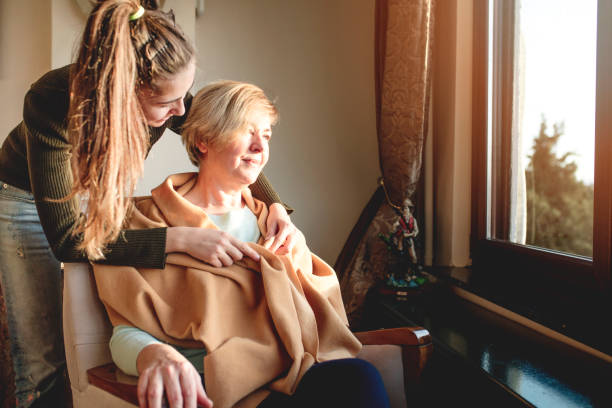Sundowning, a perplexing phenomenon often associated with dementia, is characterized by an emergence or escalation of neuropsychiatric symptoms in the late afternoon, evening, or night. Understanding this syndrome is crucial for those caring for individuals with dementia, as it can significantly impact the quality of life for both the patient and the caregiver.
This blog aims to provide an insight into the nature of sundowning, its triggers, and potential coping strategies, shedding light on this lesser-known aspect of dementia.
Contents
Understanding the Causes of Sundowning
While the exact causes of sundowning are not fully understood, several factors are believed to contribute to its occurrence.
On a physiological level, the internal body clock of an individual with dementia may be disrupted, leading to confusion between night and day. This internal ‘circadian’ rhythm controls many aspects of our physiology and behavior, such as sleep patterns, body temperature, and hormone levels. In dementia patients, these rhythms may be disturbed, causing increased restlessness and agitation during the night.
Environmental factors can also play a significant role in triggering sundowning. Poor lighting and increased shadows can cause confusion and fear for those with dementia, exacerbating sundowning symptoms. Additionally, the transition from a usually noisy daytime environment to a quieter evening atmosphere can potentially cause anxiety and restlessness.
Lastly, fatigue significantly contributes to sundowning. As the day progresses, the accumulation of stimuli can tire a dementia patient, leading to an increase in confusion and agitation as the day ends. The dementia patient’s reduced ability to handle stress, common experiences of discomfort such as hunger or thirst, and reactions to certain medications may also be contributing factors. Caregivers are encouraged to monitor these elements closely to better manage and potentially alleviate sundowning symptoms.
Practical Strategies to Manage Sundowning

Implementing certain practical strategies can aid in managing the symptoms of sundowning. A successful approach often involves a combination of environmental modifications, behavioral strategies, and maintaining good health practices. Understanding and adapting to the unique needs and behaviors of the individual with dementia is crucial for the efficacy of these strategies.
Below are some suggestions to help manage sundowning:
- Establish a consistent daily routine: A predictable and structured daily routine can help reduce confusion and agitation for individuals with dementia. This includes regular mealtimes, sleep schedules, and activities.
- Create a comfortable environment: Maintain adequate lighting, minimize shadows or glare, and eliminate excess noise that may cause discomfort or fear in the individual.
- Engage in activities: Keeping the individual with dementia engaged and stimulated during the day can help reduce restlessness and agitation at night. Activities such as puzzles, music therapy, or light exercise can be beneficial.
- Monitor medication use: Certain medications may contribute to sundowning symptoms, so it is essential to communicate any changes or concerns with a healthcare professional.
- Use calming techniques: Calming techniques such as massage, aromatherapy, or relaxation exercises can help alleviate anxiety and agitation in individuals with dementia.
- Ensure proper nutrition and hydration: Proper nutrition and hydration are essential for overall health and well-being and may also contribute to reducing sundowning symptoms.
- Seek support: Caring for someone with dementia can be challenging, so it is essential to seek support from other caregivers, healthcare professionals, or support groups.
The Role of Healthcare Professionals in Managing Sundowning
Healthcare professionals play an integral role in managing sundowning in patients with dementia. They are not only equipped with the requisite knowledge about the condition but also have the training to implement effective strategies to manage its symptoms. They can provide a comprehensive evaluation of the patient’s physical and mental health, identify potential triggers, and develop a personalized care plan. Furthermore, they can monitor the progress and effectiveness of the interventions, making necessary adjustments for optimal results.
A key aspect of their role involves medication management. Healthcare professionals can review the patient’s medication regimen, identify any drugs that may exacerbate sundowning symptoms, and suggest suitable alternatives. They can also recommend medications that can help alleviate symptoms such as agitation, restlessness, and insomnia. However, it is important to note that the use of medication should always be considered as a last resort when non-pharmacological interventions have been unsuccessful.
Lastly, healthcare professionals serve as a vital source of support and education for caregivers. They can provide caregivers with the needed guidance on how to manage sundowning, offer advice on coping strategies, and educate them about the nature of the condition. This support can significantly alleviate the stress associated with caring for a loved one with dementia. By empowering caregivers with knowledge and skills, healthcare professionals contribute significantly to improving the quality of life for both the patient and the caregiver.
Conclusion
Sundowning is a common and challenging symptom of dementia that impacts the daily lives of both patients and caregivers. While its causes are not fully understood, implementing practical strategies and seeking support from healthcare professionals can greatly alleviate its symptoms. By understanding the unique needs and behaviors of individuals with dementia, we can provide them with the care and support they need to live a more comfortable and fulfilling life.
With continued research, education, and support from healthcare professionals, we can continue to improve our understanding of sundowning and develop more effective ways of managing its symptoms.

